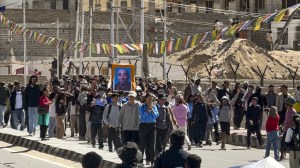Stay updated with the latest - Click here to follow us on Instagram
Unsolved Crimes: Six years and 1,500 DNA tests later, rape, murder of three girls still a mystery
One by one, the police began to eliminate each suspect after a thorough probe revealed that immediate family members and known male acquaintances had strong alibis. However, no one was exempt from undergoing a DNA test.
 It began with the discovery of the body of a three-year-old girl at Vij Bhavan, not far from her home in Cuffe Parade’s Shiv Shakti Nagar slum colony, on October 19, 2011. The next year, on April 12, 2012, the body of a three-and-a-half-year-old girl was found in the sea behind Maker Chambers in Cuffe Parade. (Representational Image)
It began with the discovery of the body of a three-year-old girl at Vij Bhavan, not far from her home in Cuffe Parade’s Shiv Shakti Nagar slum colony, on October 19, 2011. The next year, on April 12, 2012, the body of a three-and-a-half-year-old girl was found in the sea behind Maker Chambers in Cuffe Parade. (Representational Image)
NEW officers assigned to the detection squad at Cuffe Parade police station quickly learnt what would be the top priority through the duration of their posting. It is the case that has frustrated detectives in south Mumbai for close to seven years now. The case in which three young girls were abducted, raped and murdered in Cuffe Parade and Colaba in the space of nine months in 2011-2012. Among the rewards awaiting the policeman or woman who catches the culprit is a chance at earning legendary status and giving closure to the families of the three dead girls.
It began with the discovery of the body of a three-year-old girl at Vij Bhavan, not far from her home in Cuffe Parade’s Shiv Shakti Nagar slum colony, on October 19, 2011. The next year, on April 12, 2012, the body of a three-and-a-half-year-old girl was found in the sea behind Maker Chambers in Cuffe Parade. The police said that she had disappeared from the home of her grandmother in nearby Ambedkar Nagar slum colony. Both the girls had been killed with a blow to the back of the head with a blunt object, investigations revealed.
The body of another girl of the same age was found near Vij Bhavan on June 18, 2012. The police said that the three-year-old victim had disappeared from her home in Sassoon Docks, Colaba, and had been strangled to death. Post-mortem examinations concluded that all three girls had been sexually assaulted.
With no eye witnesses, the police expected to identity the suspect on the basis of findings of the DNA tests conducted on articles found on the bodies. It seemed at that time a matter of tracing the person whose DNA matched the sample from among a pool of family, friends, neighbours and known sexual offenders in the locality.
One by one, the police began to eliminate each suspect after a thorough probe revealed that immediate family members and known male acquaintances had strong alibis. However, no one was exempt from undergoing a DNA test. With intense pressure to find the rapist-killer, samples of suspects were tested on a priority basis at the Kalina Forensic Science Laboratory.
“Each time a DNA test would come negative, it was disappointing,” says Janardhan Kharat, senior inspector at Cuffe Parade police station at the time of the murders. There would be much more of that in store for Kharat and his successors as the field of suspects kept expanding. Till date, the police have sent DNA samples of more than 1,500 men for forensic testing, only for each of them to return negative.
In the first few months, Kharat adds, information about possible leads came in thick and fast but none of them was reliable. In the meantime, officers at both police stations looked at each new case of sexual assault or murder of a toddler in the city and state with renewed hope and requested a DNA test of the suspect.
After the original set of police officers who probed the case were transferred out, those next in line were handed over a large sheaf of papers to study. “We have tried to look at the case with a fresh eye, but haven’t found one angle that has not yet been covered,” says a detection officer at Cuffe Parade.
The official, who took over the case a year ago, says even the number of suspects remains unclear. “Even now we do not ignore even the smallest of clues,” adds the officer. Recently, locals in Ambedkar Nagar dragged four men roaming around suspiciously, to the police station. A round of DNA tests later, they too were added to the list of men ruled out. “In spite of the rejections, the case is still on everyone’s mind. At every meeting, senior officials want to know what the status of the case is,” says the officer.
Inspector General of Police Krishna Prakash, who served as Additional Commissioner of Police (South Mumbai) at that time, said the police had worked very hard on the cases, nabbed several suspects but had not received a single match. At the moment, the cases hang between being closed and investigated on sole priority — more recent cases occupy more time. Families of the three girls have also stopped visiting the police station as frequently as they used to. The father of the first girl, who previously worked as a daily wage worker, developed an alcohol addiction, the police said.
Assistant Commissioner of Police Shekhar Tawde, who was the inspector assigned to the case in 2014, twice proposed filing an A Summary report in the cases, whereby the investigation would be resumed as and when credible information was received. His proposals were not accepted. “There is no new evidence to be found. Whoever is responsible either never returned to Mumbai since 2012 or is now dead,” said Sharad Barde, who served as senior inspector at Cuffe Parade in 2014.
In spite of that, there is a belief that the police are only one positive DNA match away from making a breakthrough. “This is a case every officer would like to solve. Tawde used to tell me, ‘ki yeh case detect hoga toh naam banega aur un bacchon ke parivaron ko sukoon milegi’ (We will become famous if we crack this case and we will be able to bring peace to the families of the children),” adds Barde.







